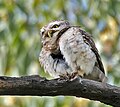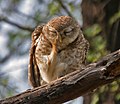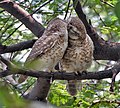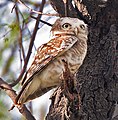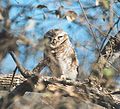Spotted owlet: Difference between revisions
re-arranged video for better effect & removed space |
fmt refs |
||
| Line 6: | Line 6: | ||
| status = LC |
| status = LC |
||
| status_system = IUCN3.1 |
| status_system = IUCN3.1 |
||
| status_ref = <ref name=bi>{{ cite web |url=http://www.birdlife.org/datazone/species/index.html?action=SpcHTMDetails.asp&sid=2288&m=0 |title=Spotted Owlet - BirdLife Species Factsheet |author=Compilers: Stuart Butchart, Jonathan Ekstrom |work=Evaluators: Jeremy Bird, Stuart Butchart |publisher=[[BirdLife International]]. |year=2008 |accessdate=June 1, 2009 }}</ref> |
| status_ref = <ref>{{IUCN2008|assessors=BirdLife International|year=2008|id=143287|title=Athene brama|downloaded=02 June 2009}}</ref><ref name=bi>{{ cite web |url=http://www.birdlife.org/datazone/species/index.html?action=SpcHTMDetails.asp&sid=2288&m=0 |title=Spotted Owlet - BirdLife Species Factsheet |author=Compilers: Stuart Butchart, Jonathan Ekstrom |work=Evaluators: Jeremy Bird, Stuart Butchart |publisher=[[BirdLife International]]. |year=2008 |accessdate=June 1, 2009 }}</ref> |
||
| regnum = [[Animal]]ia |
| regnum = [[Animal]]ia |
||
| phylum = [[Chordate|Chordata]] |
| phylum = [[Chordate|Chordata]] |
||
| Line 16: | Line 16: | ||
| binomial = ''Athene brama'' |
| binomial = ''Athene brama'' |
||
| binomial_authority = ([[Coenraad Jacob Temminck|Temminck]], 1821) |
| binomial_authority = ([[Coenraad Jacob Temminck|Temminck]], 1821) |
||
| synonyms = ''Carine brama''<ref>Baker, E. C. S. |
| synonyms = ''Carine brama''<ref>{{cite journal|author=Baker, E. C. S.|year=1919|title= Descriptions of subspecies of ''Carine brama''.|journal=Bulletin B.O.C.|volume=40|pages=60-61}}</ref><ref name=ap> Note: The name ''"brama"'' is from the French name ''"Chouette brame"'' and indirectly refers to this owl's Indian habitat by way of homage to [[Brahma]], the Hindu supreme spirit. In [[Hindu mythology]] the [[owl]] is a [[vahan]] (mode of transport) of [[Lakshmi]], goddess of wealth.{{ cite journal|journal=Buceros|volume=9|issue=2|url=http://www.bnhsenvis.nic.in/Vol%209%20(2)dictionary.pdf |title=A dictionary of scientific bird names originating from the Indian region |author=Pittie, Aasheesh|year=2004|pages=1-31|accessdate=April 27, 2009}}</ref><br/>''Noctua indica'' <small>Franklin, 1831</small> |
||
}} |
}} |
||
[[Image:Spotted Owlet (Athene brama) at Kolkata I IMG 2200.jpg|thumb|307px|Peering from a roost cavity ([[Kolkata]], India)]] |
[[Image:Spotted Owlet (Athene brama) at Kolkata I IMG 2200.jpg|thumb|307px|Peering from a roost cavity ([[Kolkata]], India)]] |
||
The '''Spotted Owlet''' (''Athene brama'') is |
The '''Spotted Owlet''' (''Athene brama'') is a small [[owl]] which breeds in tropical [[Asia]] from [[India]] to [[Southeast Asia]]. They are very common species and have adapted to living in cities. They roost in small groups in the hollows of trees or in cavities in rocks or buildings. This species is a part of the larger grouping of owls known as [[typical owl]]s, Strigidae. |
||
[[Image:Spotted Owlet I IMG 6313.jpg|thumb|upright|left|307px| In [[Kolkata]], [[West Bengal]], [[India]]. ]] |
[[Image:Spotted Owlet I IMG 6313.jpg|thumb|upright|left|307px| In [[Kolkata]], [[West Bengal]], [[India]]. ]] |
||
The Spotted Owlet is a common resident bird in open habitats including farmland and human habitation. It nests in a hole in a tree or building, laying 3-5 eggs. Nests near human habitations were found to show higher breeding success with |
The Spotted Owlet is a common resident bird in open habitats including farmland and human habitation. It nests in a hole in a tree or building, laying 3-5 eggs. Nests near human habitations were found to show higher breeding success with the young being fed a greater number of rodents.<ref>{{cite journal|author=Pande, Satish; Amit Pawashe; Murlidhar N. Mahajan; Charu Joglekar & Anil Mahabal |year=2007|title= Effect of Food and Habitat on Breeding Success in Spotted Owlets (''Athene brama'') Nesting in Villages and Rural Landscapes in India.|journal= Journal of Raptor Research |volume=41|issue=1|pages=26-34|doi=10.3356/0892-1016(2007)41[26:EOFAHO]2.0.CO;2}}</ref> |
||
==Description== |
==Description== |
||
The Spotted Owlet is small (21cm) and stocky. The upperparts are grey-brown, heavily spotted with white. The underparts are white, streaked with brown. The facial disc is pale and the iris is yellow. There is a white neckband and supercilium. Sexes are similar. The flight is deeply undulating. In Baluchistan it overlaps with the Little Owl from which it can be separated by the unstreaked crown and narrow tail bands. The nominate form is darker than the paler forms such as ''indica'' of drier regions.<ref name=pcr>Rasmussen PC & JC Anderton |
The Spotted Owlet is small (21cm) and stocky. The upperparts are grey-brown, heavily spotted with white. The underparts are white, streaked with brown. The facial disc is pale and the iris is yellow. There is a white neckband and supercilium. Sexes are similar. The flight is deeply undulating. In Baluchistan it overlaps with the Little Owl from which it can be separated by the unstreaked crown and narrow tail bands. The nominate form is darker than the paler forms such as ''indica'' of drier regions.<ref name=pcr>{{cite book|author=Rasmussen PC & JC Anderton|year=2005|title=Birds of South Asia: The Ripley Guide.|publisher=Smithsonian Institution & Lynx Edicions|volume=2|pages=246-247}}</ref> |
||
When disturbed from their daytime site, they bob their head and stare at intruders.<ref>Ali, |
When disturbed from their daytime site, they bob their head and stare at intruders.<ref>{{cite book|author=Ali, Salim|year=1996|title=The Book of Indian Birds.|publisher=Oxford University Press|edition=12}}</ref> |
||
Several subspecies have been described but only about five are widely accepted (the race ''poikila''<ref> |
Several subspecies have been described but only about five are widely accepted (the race ''poikila''<ref>{{cite journal|author=Lan, Yang;Li Gui-yuan |year=1989|title= A New Subspecies of The ''Athene brama'' (Spotted Little Owl)—A. b. poikila (Belly-mottled Little Owl).|journal= Zoological Research |volume=10|issue=4|pages=303-308}}</ref> is invalid and refers to ''Aegolius funereus''<ref>{{cite journal|author=Sun, Yue-Hua; Bi Zhong-Lin; Wolfgang Scherzinger |year=2003|title= Belly-mottled little owl ''Athene brama poikila'' should be boreal owl (''Aegolius funereus beickianus'').|journal= Current Zoology |volume=49|issue=3|pages=389-392|url=http://www.actazool.org/paperdetail.asp?id=424}}</ref>): |
||
* ''albida'' [[Walter Norman Koelz|Koelz]], 1950 is found in western Asia in Iran and Pakistan |
* ''albida'' [[Walter Norman Koelz|Koelz]], 1950 is found in western Asia in Iran and Pakistan |
||
* ''indica'' (Franklin, 1831) is found in northern India |
* ''indica'' (Franklin, 1831) is found in northern India |
||
| Line 36: | Line 36: | ||
==Behaviour and ecology== |
==Behaviour and ecology== |
||
This species is nocturnal but is sometimes seen in the day. It can often be located by the small birds that mob it while it is perched in a tree. It hunts a variety of insects and small vertebrates. In Pakistan they have been found to take mostly insect prey.<ref>Shah, Z.A. and M.A. Beg |
This species is nocturnal but is sometimes seen in the day. It can often be located by the small birds that mob it while it is perched in a tree. It hunts a variety of insects and small vertebrates. In Pakistan they have been found to take mostly insect prey.<ref>{{cite journal|author=Shah, Z.A. and M.A. Beg|year= 2001|title= Food of the Spotted Little Owl (''Athene brama'') at a place where a cropland and a Sandy wasteland met.|journal= Pakistan J. Zool.|volume= 33|pages= 53–56}}</ref><ref>{{cite journal|author=Shah, Zahid Ali; Mirza Azhar Beg & Akbar Ali Khan|year=2004|title= Prey Preferences of the Spotted Little Owl (''Athene brama'') in the Croplands Near Faisalabad–Pakistan.|journal= Int. J. Agri. Biol.|volume=6|issue=2|pages=278-280|url=http://www.fspublishers.org/ijab/past-issues/IJABVOL_6_NO_2/16.pdf |format=PDF}}</ref><ref>{{cite journal|author=Shah, Z.A. & M.A. Beg|year=2001|title= Food of the Spotted Little Owl (''Athene brama'') at a place where a cropland and a Sandy wasteland met. |journal=Pakistan J. Zool.|volume= 33|pages=53–56}}</ref> |
||
<ref>Beg, M.A., M. Maqbool |
<ref>{{cite journal|author=Beg, M.A., M. Maqbool & M. Mushtaq–ul–Hassan|year=1990|title=Food habits of spotted owlet, ''Athene brama''.|journal=Pakistan J. Agri. Sci.|volume=27|pages=127–131}}</ref> In the arid region of Jodhpur, they have been found to take more rodents (especially in the genus ''Mus'' and tend to avoid other rodends such as ''Tatera'') just prior to the breeding season.<ref>{{cite journal|author=Jain AP, R Advani|year=1983|title= Winter food of spotted owlet, ''Athene brama indica''.|journal= Journal of the Bombay Natural History Society|volume= 80|issue=2|pages=415-416}}</ref> Bats, toads, small snakes such as ''[[Ramphotyphlops braminus]]'' have been noted.<ref name=zp/> They may also take scorpions and molluscs.<ref>{{cite journal|author=Pande, S., A. Pawashe, D.B. Bastawade & P.P. Kulkarni |year=2004|title=Scorpions and molluscs: some new dietary records for Spotted Owlet ''Athene brama'' in India. |journal=Newsletter for Ornithologists|volume= 1|issue=5|pages=68-70}}</ref> |
||
The breeding season is November to April.<ref name=pcr/> Courtship behaviour includes bill grasping, allopreening and ritual feeding. The female may call with the male, bob head and deflecting their tail in invitation.<ref>Hassan, Mehmood-ul |
The breeding season is November to April.<ref name=pcr/> Courtship behaviour includes bill grasping, allopreening and ritual feeding. The female may call with the male, bob head and deflecting their tail in invitation.<ref>{{cite journal|author=Hassan, Mehmood-ul|year=2008|title=Some observations on behaviour of Spotted Owlet (''Athene brama'') during its breeding season.|journal= J. Anim. Pl. Sci.|volume=18|issue=1|pages=47-49|url=http://hisoft.us/sites/japs/docs/18_1_2008/07-732-Mahmood-Final.pdf|format=PDF}}</ref> The social organization of family groups is not clear and multiple males may copulate with a female and females may attempt [[pseudocopulation]]<ref>{{cite journal|author=Pravin Charde & Raju Kasambe|year=2007|title=Study of the mounting behaviour of Spotted Owlets ''Athene brama'' in Maharashtra, India.|journal= Abstracts of World owl conference|url=http://worldowlconference.com/downloads/Abstracts%20for%20Oral%20Presentations.pdf|format=PDF}}</ref> in possible displacement coition displays.<ref>{{cite journal|author=Watson, Adam|year=1957|title=The behaviour, breeding, and food-ecology of the snowy owl ''Nyctea scandiaca''.|journal=Ibis|volume=99|issue=3|pages=419-462}}</ref><ref>{{cite journal|author=Kasambe, Raju|year=2004|title= Unusual mounting behaviour of a female Spotted Owlet (''Athene brama'').|journal= Newsletter for Birdwatchers|volume=44|issue=4|pages=63-64}}</ref> They nest in cavities often competing with other hole-nesters such as mynas. They may also nest in holes in vertical embankments.<ref>{{cite journal|author=Satish Pande, Amit Pawashe, M.N. Mahajan & Anil Mahabal|year=2006|title= Changing nest site preference for holes in earth cuttings in Spotted Owlet ''Athene brama''.|journal= Indian Birds|volume=2|issue=1|pages=7-8|url=http://www.indianbirds.in/pdfs/Changing%20nest%20site%20preference.pdf|format= PDF}}</ref> The nest may be lined with leaves and feathers or may use the existing lining from a prior occupant. The typical clutch size is three or four and the white eggs are very spherical (30.9mm long and 26.3 mm wide, 11.6g). The young were fed mainly with insects such as cockroaches and toads (''[[Bufo stomaticus]]'' noted in Gujarat) Only one or two chicks may fledge and they leave the nest in about 20 days.<ref name=zp>{{cite journal|author=Anika Jadhav, Parasharya, B. M.|year=2003|title= Some observations on the nesting behaviour and food of the spotted owlet ''Athene brama''.|journal= Zoos'print journal|volume=18|issue=8|pages=1163-1165|url=http://www.zoosprint.org/ZooPrintJournal/2003/August/1163-1165.pdf|format=PDF}}</ref> |
||
The call is a harsh and loud churring and chuckling ''chirurr-chirurr-chirurr'' ending with a ''chirwak-chirwak'' and they call mainly during early dawn or just after sunset.<ref>Brahmachary, R. L.; Basu, T. K.; Sengupta, A. J. |
The call is a harsh and loud churring and chuckling ''chirurr-chirurr-chirurr'' ending with a ''chirwak-chirwak'' and they call mainly during early dawn or just after sunset.<ref>{{cite journal|author=Brahmachary, R. L.; Basu, T. K.; Sengupta, A. J. |year=1972|title= On the daily screeching time of a colony of spotted owls ''Athene brama'' (Temminck).|journal= J. Bombay Nat. Hist. Soc.|volume=69|issue=3|pages=649-651}}</ref><ref name=pcr/> |
||
Brain anatomy reveals that they have a pineal gland, a feature which was said to be absent in the owls.<ref>Haldar, Chandana; Prasenjit Guchhait |
Brain anatomy reveals that they have a pineal gland, a feature which was said to be absent in the owls.<ref>{{cite journal|author=Haldar, Chandana; Prasenjit Guchhait |year=2000|title=Pineal gland of a nocturnal bird, Indian spotted owlet,''Athene brama'': Morphological and endocrine observations.|journal= Journal of Experimental Zoology|volume= 287|issue=2|pages=145-150|doi=10.1002/1097-010X(20000701)287:2<145::AID-JEZ4>3.0.CO;2-K}}</ref> Birds show variation in the melatonin concentration between day and night. A high melatonin level is associated with sleep and low levels are associated with high alertness and foraging activity. Spotted Owlets however show only a slightly lower melatonin concentration at night with a slight increase in the early afternoon. Other owls such as the Barn Owl show little day-night variation.<ref>{{cite journal|author=Guchhait P, Haldar C|year=1999 |title= Circadian rhythms of melatonin and sex steroids in a nocturnal bird, Indian spotted owlet ''Athene brama'' during reproductively active and inactive phases.|journal=Biol Rhythm Res.|volume=30|pages=508–516}}</ref><ref>{{cite journal|author=Martin Wikelski, Elisa M. Tarlow, Corine M. Eising,Ton G.G. Groothuis, Ebo Gwinner|year=2005|title=Do night-active birds lack daily melatonin rhythms? A case study comparing a diurnal and a nocturnal-foraging gull species.|journal=J. Ornithol.|volume=147|issue=1|pages=107-111|doi=10.1007/s10336-005-0018-4|url=http://www.princeton.edu/~wikelski/Publications/2005%20Wikelski%20et%20al%20Gulls%20J%20Ornithol.pdf |format=PDF}}</ref> Seasonal changes in glandular activity have been associated with environmental factors such as temperature and humidity.<ref>{{cite journal|author=Chandana Haldar; C.C. Sudha Kumari; Prasenjit Guchhait |year=2002|title= Seasonal Adreno-Cortical Cycle of a Nocturnal Bird, Indian Spotted Owlet ''Athene brama'': Biochemical and Morphological Observations. |journal=Biological Rhythm Research |volume=33|issue=1|pages=53-63|doi=10.1076/brhm.33.1.53.1323}}</ref> |
||
A coccidian parasites, ''[[Eimeria atheni]]'' has been described from this species.<ref>Chauhan M.P.S., Jain S.P. |
A coccidian parasites, ''[[Eimeria atheni]]'' has been described from this species.<ref>{{cite journal|author=Chauhan M.P.S., Jain S.P.|year=1979|title= A new coccidium, ''Eimeria atheni'' from a spotted owlet, ''Athene brama'' (Temminck).|journal= Riv. Parassitol. |volume=40|pages=167-169}}</ref> An ectoparasitic mite, ''Neocheletiella athene'' has been described from a specimen from the Antwerp zoo.<ref>{{cite journal|author=Fain, Alex & Andre V Bochkov|year=2001|title= On some new or little known species of parasitic Cheyletidae (Acari:Prostigmata).|journal= Acaralogia|volume=52|issue=2|pages=145-160|url=http://insects.ummz.lsa.umich.edu/ACARI/staff/bochkov/Bochkov-paper/Bochkov-2002/FainBochkov(4)2002.pdf |format=PDF}}</ref> Bird lice of the species ''Colpocephalum pectinatum'' are known to be ectoparasites.<ref>{{cite journal|author=Price, Roger D. & James R. Beer |year=1963|title= The Species of Colpocephalum (Mallophaga: Menoponidae) Known to Occur on the Strigiformes.|journal= Journal of the Kansas Entomological Society|volume= 36|issue=1|pages=58-64}}</ref> |
||
==In culture== |
==In culture== |
||
These birds being very familiar to humans especially with their loud calling have been associated with bad omens.<ref>H. A. Rose |
These birds being very familiar to humans especially with their loud calling have been associated with bad omens.<ref>{{cite journal|author=H. A. Rose |year=1910 |title=Panjab Folklore Notes.|journal= Folklore|volume= 21|issue=2|pages=216-217}}</ref> |
||
==References== |
==References== |
||
{{reflist|2}} |
{{reflist|2}} |
||
==Other sources== |
==Other sources== |
||
* Kumar,TS; Rao,JVR |
* {{cite journal|author=Kumar,TS; Rao,JVR |year=1984|title= Diurnal changes in the body temperature of nestling Spotted Owlet, ''Athene brama brama'' (T). |journal=Geobios, Jodhpur |volume=11|issue=5|pages=216-218}} |
||
* Lamba,BS; Tyagi,AK |
* {{cite journal|author=Lamba,BS; Tyagi,AK |year=1976|title= Incubation period in Northern Spotted Owlet, ''Athene brama indica'' (Franklin). |journal=Newsl. Zool. Surv. India|volume= 2|issue=4|pages=128-129}} |
||
* Suresh, Kumar T. |
* {{cite book|author=Suresh, Kumar T. |year=1980|title= The life-history of the Spotted Owlet (''Athene brama brama'' Temminck) in Andhra Pradesh.|publisher= Raptor Research Centre, Hyderabad. Pub. No. 4.}} |
||
* Mahmood-ul-Hassan, Muhammad; Beg, Mirza Azhar; Mushtaq-ul-Hassan, Muhammad; Rana, Shahnaz Ahmed |
* {{cite journal|author=Mahmood-ul-Hassan, Muhammad; Beg, Mirza Azhar; Mushtaq-ul-Hassan, Muhammad; Rana, Shahnaz Ahmed |year=2007|title= Nesting and Breeding Habits of the Spotted Owlet (''Athene brama'') in Punjab, Pakistan.|journal= Journal of Raptor Research|volume= 41|issue=1|pages=50-52}} |
||
==External links== |
==External links== |
||
{{commonscat|Athene brama}} |
{{commonscat|Athene brama}} |
||
{{wikispecies|Athene brama}} |
{{wikispecies|Athene brama}} |
||
* {{IUCN2008|assessors=BirdLife International|year=2008|id=143287|title=Athene brama|downloaded=02 June 2009}} Database entry includes justification for why this species is of Least Concern. |
|||
* [http://ibc.lynxeds.com/species/spotted-owlet-athene-brama Internet Bird Collection] |
* [http://ibc.lynxeds.com/species/spotted-owlet-athene-brama Internet Bird Collection] |
||
* [http://www.owlpages.com/owls.php?genus=Athene&species=brama Owl pages] |
* [http://www.owlpages.com/owls.php?genus=Athene&species=brama Owl pages] |
||
Revision as of 14:21, 26 June 2009
| Spotted Owlet | |
|---|---|

| |
| Pair of Spotted Owlets allopreening in Keoladeo National Park, Bharatpur, Rajasthan, India. | |
| Scientific classification | |
| Kingdom: | |
| Phylum: | |
| Class: | |
| Order: | |
| Family: | |
| Genus: | |
| Species: | A. brama
|
| Binomial name | |
| Athene brama (Temminck, 1821)
| |
| Synonyms | |

The Spotted Owlet (Athene brama) is a small owl which breeds in tropical Asia from India to Southeast Asia. They are very common species and have adapted to living in cities. They roost in small groups in the hollows of trees or in cavities in rocks or buildings. This species is a part of the larger grouping of owls known as typical owls, Strigidae.

The Spotted Owlet is a common resident bird in open habitats including farmland and human habitation. It nests in a hole in a tree or building, laying 3-5 eggs. Nests near human habitations were found to show higher breeding success with the young being fed a greater number of rodents.[5]
Description
The Spotted Owlet is small (21cm) and stocky. The upperparts are grey-brown, heavily spotted with white. The underparts are white, streaked with brown. The facial disc is pale and the iris is yellow. There is a white neckband and supercilium. Sexes are similar. The flight is deeply undulating. In Baluchistan it overlaps with the Little Owl from which it can be separated by the unstreaked crown and narrow tail bands. The nominate form is darker than the paler forms such as indica of drier regions.[6]
When disturbed from their daytime site, they bob their head and stare at intruders.[7]
Several subspecies have been described but only about five are widely accepted (the race poikila[8] is invalid and refers to Aegolius funereus[9]):
- albida Koelz, 1950 is found in western Asia in Iran and Pakistan
- indica (Franklin, 1831) is found in northern India
- brama (Temminck, 1821) is found in southern India[4]
- ultra Ripley, 1948 (not always recognized) is found in northeastern India and is said to have no white spots on mantle
- pulchra Hume, 1873 is found in Southeast Asia from Myanmar and Thailand into Cambodia and Vietnam
Behaviour and ecology
This species is nocturnal but is sometimes seen in the day. It can often be located by the small birds that mob it while it is perched in a tree. It hunts a variety of insects and small vertebrates. In Pakistan they have been found to take mostly insect prey.[10][11][12] [13] In the arid region of Jodhpur, they have been found to take more rodents (especially in the genus Mus and tend to avoid other rodends such as Tatera) just prior to the breeding season.[14] Bats, toads, small snakes such as Ramphotyphlops braminus have been noted.[15] They may also take scorpions and molluscs.[16]
The breeding season is November to April.[6] Courtship behaviour includes bill grasping, allopreening and ritual feeding. The female may call with the male, bob head and deflecting their tail in invitation.[17] The social organization of family groups is not clear and multiple males may copulate with a female and females may attempt pseudocopulation[18] in possible displacement coition displays.[19][20] They nest in cavities often competing with other hole-nesters such as mynas. They may also nest in holes in vertical embankments.[21] The nest may be lined with leaves and feathers or may use the existing lining from a prior occupant. The typical clutch size is three or four and the white eggs are very spherical (30.9mm long and 26.3 mm wide, 11.6g). The young were fed mainly with insects such as cockroaches and toads (Bufo stomaticus noted in Gujarat) Only one or two chicks may fledge and they leave the nest in about 20 days.[15] The call is a harsh and loud churring and chuckling chirurr-chirurr-chirurr ending with a chirwak-chirwak and they call mainly during early dawn or just after sunset.[22][6]
Brain anatomy reveals that they have a pineal gland, a feature which was said to be absent in the owls.[23] Birds show variation in the melatonin concentration between day and night. A high melatonin level is associated with sleep and low levels are associated with high alertness and foraging activity. Spotted Owlets however show only a slightly lower melatonin concentration at night with a slight increase in the early afternoon. Other owls such as the Barn Owl show little day-night variation.[24][25] Seasonal changes in glandular activity have been associated with environmental factors such as temperature and humidity.[26]
A coccidian parasites, Eimeria atheni has been described from this species.[27] An ectoparasitic mite, Neocheletiella athene has been described from a specimen from the Antwerp zoo.[28] Bird lice of the species Colpocephalum pectinatum are known to be ectoparasites.[29]
In culture
These birds being very familiar to humans especially with their loud calling have been associated with bad omens.[30]
References
- ^ Template:IUCN2008
- ^ Compilers: Stuart Butchart, Jonathan Ekstrom (2008). "Spotted Owlet - BirdLife Species Factsheet". Evaluators: Jeremy Bird, Stuart Butchart. BirdLife International. . Retrieved June 1, 2009.
{{cite web}}: CS1 maint: extra punctuation (link) - ^ Baker, E. C. S. (1919). "Descriptions of subspecies of Carine brama". Bulletin B.O.C. 40: 60–61.
- ^ a b Note: The name "brama" is from the French name "Chouette brame" and indirectly refers to this owl's Indian habitat by way of homage to Brahma, the Hindu supreme spirit. In Hindu mythology the owl is a vahan (mode of transport) of Lakshmi, goddess of wealth.Pittie, Aasheesh (2004). "A dictionary of scientific bird names originating from the Indian region" (PDF). Buceros. 9 (2): 1–31. Retrieved April 27, 2009.
- ^ Pande, Satish; Amit Pawashe; Murlidhar N. Mahajan; Charu Joglekar & Anil Mahabal (2007). "Effect of Food and Habitat on Breeding Success in Spotted Owlets (Athene brama) Nesting in Villages and Rural Landscapes in India". Journal of Raptor Research. 41 (1): 26–34. doi:10.3356/0892-1016(2007)41[26:EOFAHO]2.0.CO;2.
{{cite journal}}: CS1 maint: multiple names: authors list (link) - ^ a b c Rasmussen PC & JC Anderton (2005). Birds of South Asia: The Ripley Guide. Vol. 2. Smithsonian Institution & Lynx Edicions. pp. 246–247.
- ^ Ali, Salim (1996). The Book of Indian Birds (12 ed.). Oxford University Press.
- ^ Lan, Yang;Li Gui-yuan (1989). "A New Subspecies of The Athene brama (Spotted Little Owl)—A. b. poikila (Belly-mottled Little Owl)". Zoological Research. 10 (4): 303–308.
{{cite journal}}: CS1 maint: multiple names: authors list (link) - ^ Sun, Yue-Hua; Bi Zhong-Lin; Wolfgang Scherzinger (2003). "Belly-mottled little owl Athene brama poikila should be boreal owl (Aegolius funereus beickianus)". Current Zoology. 49 (3): 389–392.
{{cite journal}}: CS1 maint: multiple names: authors list (link) - ^ Shah, Z.A. and M.A. Beg (2001). "Food of the Spotted Little Owl (Athene brama) at a place where a cropland and a Sandy wasteland met". Pakistan J. Zool. 33: 53–56.
- ^ Shah, Zahid Ali; Mirza Azhar Beg & Akbar Ali Khan (2004). "Prey Preferences of the Spotted Little Owl (Athene brama) in the Croplands Near Faisalabad–Pakistan" (PDF). Int. J. Agri. Biol. 6 (2): 278–280.
{{cite journal}}: CS1 maint: multiple names: authors list (link) - ^ Shah, Z.A. & M.A. Beg (2001). "Food of the Spotted Little Owl (Athene brama) at a place where a cropland and a Sandy wasteland met". Pakistan J. Zool. 33: 53–56.
- ^ Beg, M.A., M. Maqbool & M. Mushtaq–ul–Hassan (1990). "Food habits of spotted owlet, Athene brama". Pakistan J. Agri. Sci. 27: 127–131.
{{cite journal}}: CS1 maint: multiple names: authors list (link) - ^ Jain AP, R Advani (1983). "Winter food of spotted owlet, Athene brama indica". Journal of the Bombay Natural History Society. 80 (2): 415–416.
- ^ a b Anika Jadhav, Parasharya, B. M. (2003). "Some observations on the nesting behaviour and food of the spotted owlet Athene brama" (PDF). Zoos'print journal. 18 (8): 1163–1165.
{{cite journal}}: CS1 maint: multiple names: authors list (link) - ^ Pande, S., A. Pawashe, D.B. Bastawade & P.P. Kulkarni (2004). "Scorpions and molluscs: some new dietary records for Spotted Owlet Athene brama in India". Newsletter for Ornithologists. 1 (5): 68–70.
{{cite journal}}: CS1 maint: multiple names: authors list (link) - ^ Hassan, Mehmood-ul (2008). "Some observations on behaviour of Spotted Owlet (Athene brama) during its breeding season" (PDF). J. Anim. Pl. Sci. 18 (1): 47–49.
- ^ Pravin Charde & Raju Kasambe (2007). "Study of the mounting behaviour of Spotted Owlets Athene brama in Maharashtra, India" (PDF). Abstracts of World owl conference.
- ^ Watson, Adam (1957). "The behaviour, breeding, and food-ecology of the snowy owl Nyctea scandiaca". Ibis. 99 (3): 419–462.
- ^ Kasambe, Raju (2004). "Unusual mounting behaviour of a female Spotted Owlet (Athene brama)". Newsletter for Birdwatchers. 44 (4): 63–64.
- ^ Satish Pande, Amit Pawashe, M.N. Mahajan & Anil Mahabal (2006). "Changing nest site preference for holes in earth cuttings in Spotted Owlet Athene brama" (PDF). Indian Birds. 2 (1): 7–8.
{{cite journal}}: CS1 maint: multiple names: authors list (link) - ^ Brahmachary, R. L.; Basu, T. K.; Sengupta, A. J. (1972). "On the daily screeching time of a colony of spotted owls Athene brama (Temminck)". J. Bombay Nat. Hist. Soc. 69 (3): 649–651.
{{cite journal}}: CS1 maint: multiple names: authors list (link) - ^ Haldar, Chandana; Prasenjit Guchhait (2000). "Pineal gland of a nocturnal bird, Indian spotted owlet,Athene brama: Morphological and endocrine observations". Journal of Experimental Zoology. 287 (2): 145–150. doi:10.1002/1097-010X(20000701)287:2<145::AID-JEZ4>3.0.CO;2-K.
{{cite journal}}: CS1 maint: multiple names: authors list (link) - ^ Guchhait P, Haldar C (1999). "Circadian rhythms of melatonin and sex steroids in a nocturnal bird, Indian spotted owlet Athene brama during reproductively active and inactive phases". Biol Rhythm Res. 30: 508–516.
- ^ Martin Wikelski, Elisa M. Tarlow, Corine M. Eising,Ton G.G. Groothuis, Ebo Gwinner (2005). "Do night-active birds lack daily melatonin rhythms? A case study comparing a diurnal and a nocturnal-foraging gull species" (PDF). J. Ornithol. 147 (1): 107–111. doi:10.1007/s10336-005-0018-4.
{{cite journal}}: CS1 maint: multiple names: authors list (link) - ^ Chandana Haldar; C.C. Sudha Kumari; Prasenjit Guchhait (2002). "Seasonal Adreno-Cortical Cycle of a Nocturnal Bird, Indian Spotted Owlet Athene brama: Biochemical and Morphological Observations". Biological Rhythm Research. 33 (1): 53–63. doi:10.1076/brhm.33.1.53.1323.
{{cite journal}}: CS1 maint: multiple names: authors list (link) - ^ Chauhan M.P.S., Jain S.P. (1979). "A new coccidium, Eimeria atheni from a spotted owlet, Athene brama (Temminck)". Riv. Parassitol. 40: 167–169.
- ^ Fain, Alex & Andre V Bochkov (2001). "On some new or little known species of parasitic Cheyletidae (Acari:Prostigmata)" (PDF). Acaralogia. 52 (2): 145–160.
- ^ Price, Roger D. & James R. Beer (1963). "The Species of Colpocephalum (Mallophaga: Menoponidae) Known to Occur on the Strigiformes". Journal of the Kansas Entomological Society. 36 (1): 58–64.
- ^ H. A. Rose (1910). "Panjab Folklore Notes". Folklore. 21 (2): 216–217.
Other sources
- Kumar,TS; Rao,JVR (1984). "Diurnal changes in the body temperature of nestling Spotted Owlet, Athene brama brama (T)". Geobios, Jodhpur. 11 (5): 216–218.
{{cite journal}}: CS1 maint: multiple names: authors list (link) - Lamba,BS; Tyagi,AK (1976). "Incubation period in Northern Spotted Owlet, Athene brama indica (Franklin)". Newsl. Zool. Surv. India. 2 (4): 128–129.
{{cite journal}}: CS1 maint: multiple names: authors list (link) - Suresh, Kumar T. (1980). The life-history of the Spotted Owlet (Athene brama brama Temminck) in Andhra Pradesh. Raptor Research Centre, Hyderabad. Pub. No. 4.
- Mahmood-ul-Hassan, Muhammad; Beg, Mirza Azhar; Mushtaq-ul-Hassan, Muhammad; Rana, Shahnaz Ahmed (2007). "Nesting and Breeding Habits of the Spotted Owlet (Athene brama) in Punjab, Pakistan". Journal of Raptor Research. 41 (1): 50–52.
{{cite journal}}: CS1 maint: multiple names: authors list (link)
External links
- Internet Bird Collection
- Owl pages
- Video of pseudocopulatory behaviour 1
- Video of pseudocopulatory behaviour 2


